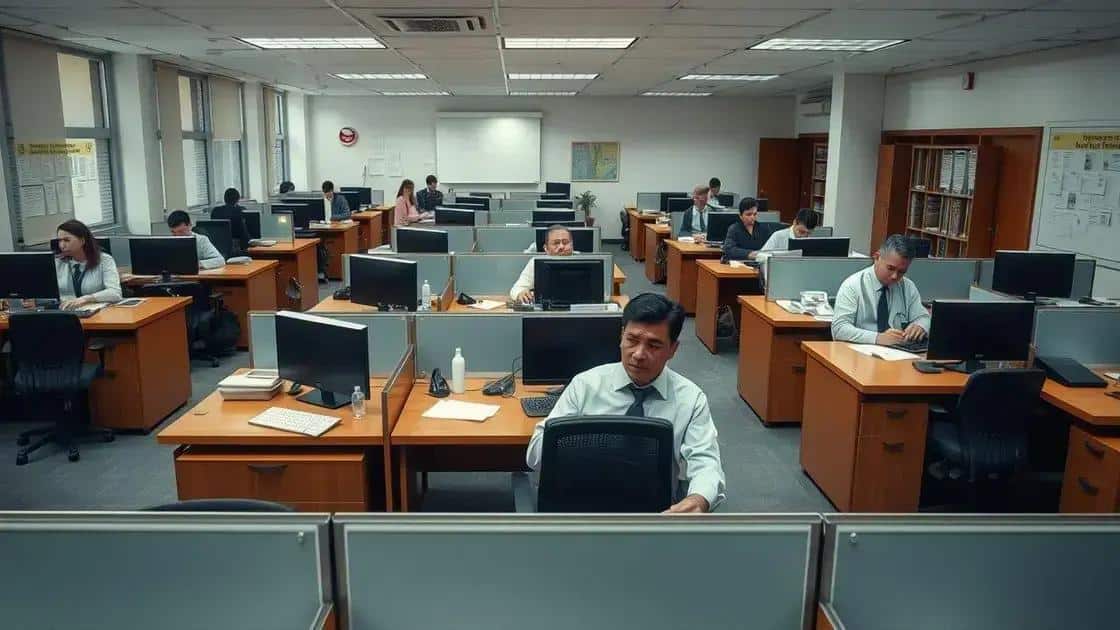Current government agency staff insufficiencies report raises alarms

Current government agency staff insufficiencies result from budget constraints, high turnover rates, and an increasing demand for services, necessitating effective recruitment strategies and employee retention efforts.
Current government agency staff insufficiencies report reveals significant challenges facing public services today. Have you ever wondered how these shortages affect your community? Let’s dive into what this means for all of us.
Understanding government agency staff insufficiencies
Understanding government agency staff insufficiencies is crucial for improving public services. These insufficiencies can hinder operations and reduce the effectiveness of agencies meant to serve the public. By examining the root causes and implications, we can address these pressing issues.
Key Factors Behind Insufficiencies
Several factors contribute to staff shortages in government agencies. One major reason is budget constraints, which limit hiring and retention. Additionally, high turnover rates can disrupt workflow and diminish agency effectiveness.
- Insufficient funding for hiring
- High employee turnover rates
- Lack of competitive salaries
- Limited career advancement opportunities
Moreover, the increasing demand for services due to population growth or crises, such as pandemics, can overstretch existing staff. When agencies struggle to meet these challenges, the quality of public services may decline.
Impacts of Staffing Shortages
Staff insufficiencies can lead to delays in service, increased workloads for remaining employees, and ultimately lower morale. This cycle can create a negative feedback loop, where existing staff feel overwhelmed and additional resignations occur, exacerbating the situation.
- Longer wait times for citizens
- Increased stress for employees
- Potential decline in service quality
- Public dissatisfaction with government services
Addressing these insufficiencies requires a multifaceted approach. Solutions may include optimizing recruitment processes, enhancing training programs, and improving workplace conditions to attract and retain skilled workers. By understanding the challenges and taking proactive steps, we can work towards a more effective and responsive government workforce.
Causes behind staffing shortages
The causes behind staffing shortages in government agencies are complex and multifaceted. Understanding these factors is essential for developing effective solutions. Key issues include budgetary constraints, competitive job markets, and workplace conditions that may not attract or retain talent.
Budgetary Constraints
One significant factor contributing to staffing shortages is limited funding. When government budgets are tight, agencies struggle to hire the necessary number of employees. These financial pressures often lead to reduced hiring and higher workloads for existing staff.
- Decreased hiring due to budget cuts
- Inability to offer competitive salaries
- Limited resources for employee benefits
- Increased competition for scarce funds
Moreover, the effects of budget cuts can create a cycle of inefficiency, where lower staff levels lead to increased delays and frustration within agencies.
Competitive Job Markets
The job market itself also plays a crucial role. With many private sector companies offering higher salaries and more flexible working conditions, government jobs can seem less appealing. This competition for talent often results in a struggle for agencies to fill open positions.
- Private sector salaries outpacing government offers
- Limited career advancement opportunities in government
- Perceptions of bureaucracy and inefficiency
- Desire for work-life balance influencing choices
Additionally, potential employees may choose professions that offer a clearer path to promotion or job satisfaction, which can further exacerbate staffing deficits within government roles.
Lastly, workplace culture and conditions have a profound impact. Agencies with high employee turnover rates and low morale may find it challenging to attract new talent. When staff feel undervalued or overwhelmed, they are more likely to leave their positions.
High Turnover Rates
High turnover can create a cycle of instability, where the constant need to hire and train new employees diverts attention from the agency’s core functions. It’s essential to identify and address these underlying causes to improve staff retention.
Consequences of inadequate staffing

The consequences of inadequate staffing in government agencies can be far-reaching and detrimental. A shortage of employees often leads to a decrease in the quality of services provided to the public. This situation impacts not only the agency but also the citizens who rely on these essential services.
Impact on Service Delivery
When agencies operate with insufficient staff, response times increase. Citizens may experience delays in accessing vital services, such as housing assistance, public health services, or licensing procedures. The quality of service delivery can suffer, resulting in frustration and dissatisfaction among the public.
- Increased wait times for services
- Lower quality of public service
- Reduced accessibility to essential programs
- Higher likelihood of errors in service provision
Alongside these service delivery challenges, the morale of existing employees can decline significantly. When teams are stretched thin, employees face heightened stress and burnout, leading to reduced productivity and job satisfaction.
Workplace Morale and Retention
A lack of adequate staffing can create a negative workplace atmosphere. Overburdened employees may feel undervalued and unsupported, which can drive good workers to seek employment elsewhere. High turnover rates only exacerbate staffing problems, creating a continuous cycle of inadequacy.
- Declining employee morale
- Increased rates of employee burnout
- Higher staff turnover rates
- Difficulty in attracting new talent
Furthermore, inadequate staffing can strain resources and budgets. Agencies may face challenges in managing workloads, leading to inefficient use of funds and potentially higher operational costs in the long run.
Ultimately, the consequences of inadequate staffing create a ripple effect throughout government agencies. When agencies cannot provide quality service, it erodes public trust. Citizens may feel disillusioned with their government, leading to a lack of engagement and support for future initiatives.
Strategies to address staffing gaps
Implementing effective strategies to address staffing gaps is crucial for government agencies striving to improve their services. By proactively tackling these gaps, agencies can enhance operational efficiency and meet public needs more effectively.
Optimizing Recruitment Processes
One approach is to optimize recruitment processes. Streamlining hiring protocols can significantly reduce the time it takes to fill vacancies. Faster hiring ensures that agencies maintain adequate staffing levels, allowing them to respond promptly to community needs.
- Review and simplify application procedures
- Utilize digital platforms for wider reach
- Implement targeted recruitment campaigns
- Engage with community organizations for outreach
At the same time, agencies might consider offering incentives for recruitment. These can include signing bonuses or flexible work schedules that attract more candidates.
Enhancing Employee Retention
Another vital strategy is to enhance employee retention. Keeping skilled workers helps to maintain a stable workforce and decreases turnover rates. This can be achieved through initiatives that foster a positive work environment.
- Provide opportunities for professional development
- Implement recognition programs for achievements
- Ensure competitive compensation packages
- Encourage work-life balance to reduce burnout
By focusing on employee satisfaction, agencies can create a culture where staff feel valued and supported, reducing the likelihood of resignations.
Utilizing Technology and Automation
Furthermore, technology can play a pivotal role in filling staffing gaps. Automation of routine tasks can free up existing employees to focus on more critical functions. By leveraging technological tools, agencies can improve efficiency and allow staff to allocate their time more effectively.
As agencies implement these strategies, they may also consider cross-training employees. This approach ensures that more staff are capable of performing various tasks, offering greater flexibility in managing workloads during staffing shortages.
In summary, addressing staffing gaps involves a combination of optimizing recruitment processes, enhancing retention efforts, and utilizing technology. These strategies collectively contribute to building a robust workforce capable of meeting the demands of public service.
Future projections for government employment
Future projections for government employment indicate significant changes in the workforce landscape. As demands on government services evolve, the need for skilled employees will increase. Understanding these projections can help agencies prepare for upcoming challenges.
Growth in Certain Sectors
There is anticipated growth in specific sectors of government employment, particularly in public health, technology, and social services. As populations grow and new issues arise, agencies will need more professionals to address these challenges.
- Increased hiring in health-related agencies
- Higher demand for IT specialists to support digital services
- Growth in social services to assist underprivileged communities
- Expansion in environmental agencies to combat climate change
This trend suggests that government roles will increasingly focus on modern challenges, requiring adaptive skills and training.
Emphasis on Diversity and Inclusion
Future projections also highlight a strong emphasis on diversity and inclusion within the workforce. Ensuring that government agencies reflect the communities they serve is becoming a priority. This focus can lead to improved service delivery and increased public trust.
Agencies are expected to develop strategic initiatives aimed at recruiting a more diverse workforce that includes individuals from various backgrounds and experiences. Such diversity can enhance innovation and problem-solving capabilities.
Increased Use of Technology
As technology continues to evolve, government employment will likely see an increased reliance on digital tools. Automation and AI can streamline many processes, allowing government employees to focus on more complex tasks requiring human judgment.
Training programs will need to adapt to equip employees with the necessary digital skills. Furthermore, remote work options may become more prevalent, changing the traditional workplace dynamics in government roles.
Potential Challenges Ahead
However, future projections also point to potential challenges. Recruitment and retention may be hindered by budget constraints and competition with the private sector. Government agencies will need to develop creative solutions to address these challenges and attract top talent.
Anticipating these changes is essential for government entities aiming to build a highly skilled and adaptable workforce prepared to meet the needs of the future.
FAQ – Frequently Asked Questions about Government Staffing Insufficiencies
What are the main causes of staffing shortages in government agencies?
The main causes include budget constraints, high turnover rates, and increasing demands for services, making it difficult to maintain adequate staff levels.
How can recruitment processes be improved?
Recruitment processes can be improved by streamlining application procedures, utilizing digital platforms for outreach, and implementing targeted recruitment campaigns.
Why is employee retention important?
Employee retention is important because it reduces turnover, maintains institutional knowledge, and keeps operations running smoothly, ultimately improving service delivery.
What strategies can be implemented to address staffing gaps?
Strategies to address staffing gaps include enhancing recruitment efforts, improving employee satisfaction, embracing technology, and offering training programs to develop skills.






